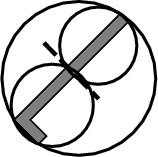
Next: Mismatched obstacles in VR Up: 8.3.3 Collision detection Previous: Simple collision tests Contents Index
Suppose that a virtual world has been defined with millions of triangles. If two complicated, nonconvex bodies are to be checked for collision, then the computational cost may be high. For this complicated situation, collision detection often becomes a two-phase process:
In the broad phase, hierarchical methods generally decompose each body into a tree. Each vertex in the tree represents a bounding region that contains some subset of the body. The bounding region of the root vertex contains the whole body. Two opposing criteria that guide the selection of the type of bounding region:
 |
The tree is constructed for a body, ![]() (or alternatively,
(or alternatively, ![]() )
recursively as follows. For each vertex, consider the set
)
recursively as follows. For each vertex, consider the set ![]() of all
points in
of all
points in ![]() that are contained in the bounding region. Two child
vertices are constructed by defining two smaller bounding regions
whose union covers
that are contained in the bounding region. Two child
vertices are constructed by defining two smaller bounding regions
whose union covers ![]() . The split is made so that the portion covered
by each child is of similar size. If the geometric model consists of
primitives such as triangles, then a split could be made to separate
the triangles into two sets of roughly the same number of triangles.
A bounding region is then computed for each of the children. Figure
8.12 shows an example of a split for the case of an
L-shaped body. Children are generated recursively by making splits
until very simple sets are obtained. For example, in the case of
triangles in space, a split is made unless the vertex represents a
single triangle. In this case, it is easy to test for the
intersection of two triangles.
. The split is made so that the portion covered
by each child is of similar size. If the geometric model consists of
primitives such as triangles, then a split could be made to separate
the triangles into two sets of roughly the same number of triangles.
A bounding region is then computed for each of the children. Figure
8.12 shows an example of a split for the case of an
L-shaped body. Children are generated recursively by making splits
until very simple sets are obtained. For example, in the case of
triangles in space, a split is made unless the vertex represents a
single triangle. In this case, it is easy to test for the
intersection of two triangles.
Consider the problem of determining whether bodies ![]() and
and ![]() are in
collision. Suppose that the trees
are in
collision. Suppose that the trees ![]() and
and ![]() have been
constructed for
have been
constructed for ![]() and
and ![]() , respectively. If the bounding regions of
the root vertices of
, respectively. If the bounding regions of
the root vertices of ![]() and
and ![]() do not intersect, then it is
known that
do not intersect, then it is
known that ![]() and
and ![]() are not in collision without performing any
additional computation. If the bounding regions do intersect, then
the bounding regions of the children of
are not in collision without performing any
additional computation. If the bounding regions do intersect, then
the bounding regions of the children of ![]() are compared to the
bounding region of
are compared to the
bounding region of ![]() . If either of these intersect, then the
bounding region of
. If either of these intersect, then the
bounding region of ![]() is replaced with the bounding regions of its
children, and the process continues recursively. As long as the
bounding regions intersect, lower levels of the trees are traversed,
until eventually the leaves are reached. At the leaves the algorithm tests
the individual triangles for collision, instead of bounding regions.
Note that as the trees are traversed, if a bounding region from the
vertex
is replaced with the bounding regions of its
children, and the process continues recursively. As long as the
bounding regions intersect, lower levels of the trees are traversed,
until eventually the leaves are reached. At the leaves the algorithm tests
the individual triangles for collision, instead of bounding regions.
Note that as the trees are traversed, if a bounding region from the
vertex ![]() of
of ![]() does not intersect the bounding region from a
vertex,
does not intersect the bounding region from a
vertex, ![]() , of
, of ![]() , then no children of
, then no children of ![]() have to be compared
to children of
have to be compared
to children of ![]() . Usually, this dramatically reduces the number
of comparisons, relative to a naive approach that tests all pairs of
triangles for intersection.
. Usually, this dramatically reduces the number
of comparisons, relative to a naive approach that tests all pairs of
triangles for intersection.
Steven M LaValle 2020-11-11